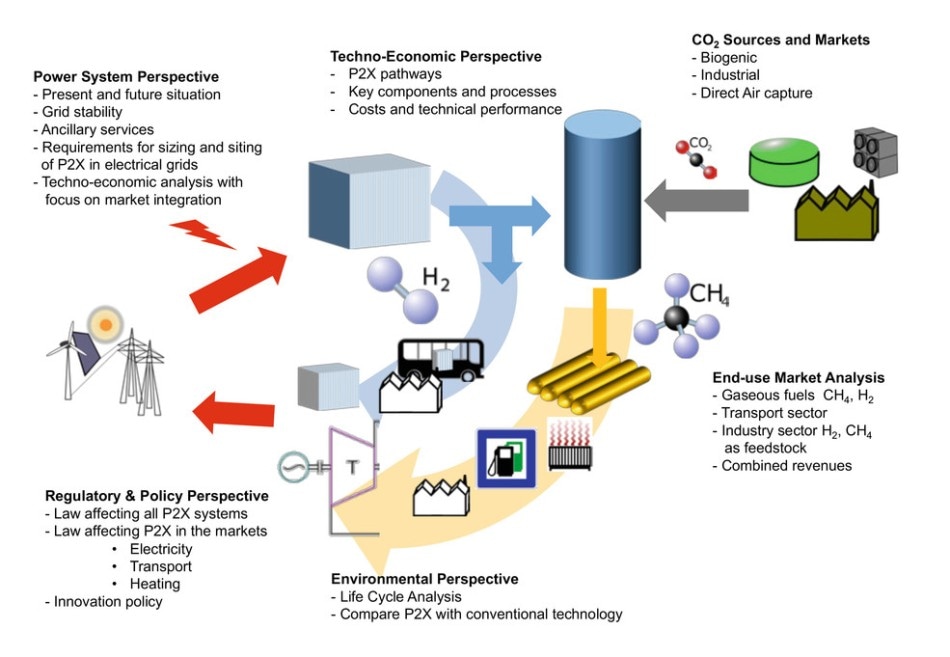Jul 4 2019
A team of researchers, as part of a joint research project of five Swiss Competence Centres for Energy Research (SCCER), has prepared a white paper on “Power-to-X” technologies for consideration by the Swiss Federal Energy Research Commission (CORE).
 (Image credit: Paul Scherrer Institute/Jörg Roth)
(Image credit: Paul Scherrer Institute/Jörg Roth)
The team comprised of researchers from the Paul Scherrer Institute (PSI), Swiss Federal Institute of Technology (ETH) Zurich, the Swiss Federal Laboratories for Materials Science and Technology (Empa), the University of Applied Sciences Rapperswil (HSR), the Zurich University for Applied Sciences (ZHAW), the University of Lucerne, and the University of Geneva.
The aim of the white paper is to gain the most significant knowledge available on Power-to-X technologies. The study, among other things, provides a better understanding of contributions that can be made to the energy strategy of Switzerland, using various technologies built on the conversion and storage of numerous forms of energy. The study findings will be presented by the experts on July 8th, 2019, at ETH Zurich.
Switzerland is aiming to significantly reduce its direct emissions of greenhouse gases. As per its Energy Strategy 2050, greenhouse gas emissions should reduce as much as 50% by 2030 when compared to 1990, and up to a maximum of 85% by 2050.
Post 2050, Switzerland’s energy supply should be climate-neutral, that is, no emissions of greenhouse gases like CO2. The so-called Power-to-X techniques are one part of the effort to meet this goal.
Here, excess electricity harvested from new renewable energy sources is used for generating — via electrochemical conversion — gaseous or liquid energy carriers like methane, hydrogen, or methanol. These energy carriers are subsequently used in the consumer industries to regenerate electricity or heat, or power vehicles. The benefit is that the gaseous or liquid energy sources can be preserved for a longer period of time.
The Power-to-X techniques, within the framework of Energy Strategy 2050, are of major interest because new renewable energy sources from wind power or photovoltaics are not available constantly, but rather with varying intensity. In order to offset the phases of low-power generation, energy obtained from production-intensive phases is anticipated to be transiently stored with the help of Power-to-X methods.
As a result, power-to-X processes can help in balancing the demand and supply of energy over a longer time period, increasing the short-term flexibility of the electric grid via intelligent load management, and generating substitutes for both fossil fuels and raw materials for industry.
A Flexibility Option and a Link Between Energy Production and Consumption
PSI researchers, along with colleagues from six other Swiss research institutions and universities, have collected a large amount of information on numerous aspects of Power-to-X technologies, for example, their ability to contribute to Energy Strategy 2050, what are the challenges faced by each technology, and what are the major factors that could encourage their extensive use.
In comparison to other new renewable energy sources, there is a particularly high potential in Switzerland for electricity from solar facilities, which makes Power-to-X an important flexibility option and a link between energy production and consumption in a sustainable, low-CO2 energy system.
Tom Kober, Head of the Energy Economics Group, Paul Scherrer Institute
Kober is one of the lead authors of the white paper, which was commissioned by the Swiss Federal Energy Research Commission.
However, Power-to-X’s contributions in separate energy sectors, like heating and transportation or through reconversion, are quite different. Therefore, the recovery of electricity from methane, hydrogen, or other energy sources generated with Power-to-X techniques continues to be still costly.
But the costs of such so-called Power-to-Power processes could decrease by as much as two-thirds by 2030, thanks to advances in technology and increasing experience with these new technologies.
Tom Kober, Head of the Energy Economics Group, Paul Scherrer Institute
It is not yet certain as to what extent these Power-to-Power technologies will conquer over other flexibility options available in the electricity system, not least because it also relies on advancements in the European market and related conditions for Switzerland’s overseas trade in electricity.
System Integration Plays a Key Role
Fossil fuels like natural gas, heating oil, diesel, and petrol can be replaced by fuels generated with electricity from renewable sources in Power-to-X processes. While this can help in reducing CO2 emissions, this would be economically feasible only if suitable environmental incentive mechanisms come into play.
It is important to realize conversion processes as efficiently as possible to preserve resources on the one hand and reduce costs on the other. Such an approach has implications for selecting sites for Power-to-X plants and also the way the technology can be incorporated into diverse markets.
Therefore, for successful implementation of Power-to-X within the framework of Energy Strategy 2050, research and innovation should be focused on the optimal integration of Power-to-X technologies into Switzerland’s overall energy system. This was the conclusion reached by the study.
Commissioned by the Swiss Federal Energy Research Commission (CORE), the white paper was prepared by the partners of five Swiss Competence Centers for Energy Research (SCCER) — Heat and Electricity Storage, BIOSWEET, CREST, FURIES, and Mobility — and funded by Innosuisse and the Swiss Federal Office of Energy (SFOE).
The scientists will present the outcomes of the analyses for the white paper titled “Power-to-X: Perspectives in Switzerland” on July 8th, 2019, at an event to be held at ETH Zurich.